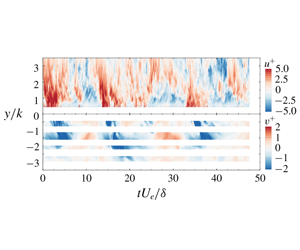Crossref Citations
This article has been cited by the following publications. This list is generated based on data provided by
Crossref.
Chavarin, Andrew
Efstathiou, Christoph
Vijay, Shilpa
and
Luhar, Mitul
2020.
Resolvent-based design and experimental testing of porous materials for passive turbulence control.
International Journal of Heat and Fluid Flow,
Vol. 86,
Issue. ,
p.
108722.
Grant, Stanley B.
Gomez‐Velez, Jesus D.
Ghisalberti, Marco
Guymer, Ian
Boano, Fulvio
Roche, Kevin
and
Harvey, Judson
2020.
A One‐Dimensional Model for Turbulent Mixing in the Benthic Biolayer of Stream and Coastal Sediments.
Water Resources Research,
Vol. 56,
Issue. 12,
Wang, Wenkang
Chu, Xu
Lozano-Durán, Adrián
Helmig, Rainer
and
Weigand, Bernhard
2021.
Information transfer between turbulent boundary layers and porous media.
Journal of Fluid Mechanics,
Vol. 920,
Issue. ,
Bryanskaya, Yuliya
Ostyakova, Aleksandra
and
Bazarov, D.
2021.
Results of hydraulic tests of the ACO Qmax system pipeline.
E3S Web of Conferences,
Vol. 264,
Issue. ,
p.
03073.
Chu, Xu
Wang, Wenkang
Yang, Guang
Terzis, Alexandros
Helmig, Rainer
and
Weigand, Bernhard
2021.
Transport of Turbulence Across Permeable Interface in a Turbulent Channel Flow: Interface-Resolved Direct Numerical Simulation.
Transport in Porous Media,
Vol. 136,
Issue. 1,
p.
165.
Wang, Wenkang
Yang, Guang
Evrim, Cenk
Terzis, Alexandros
Helmig, Rainer
and
Chu, Xu
2021.
An assessment of turbulence transportation near regular and random permeable interfaces.
Physics of Fluids,
Vol. 33,
Issue. 11,
Chavarin, A.
Gómez-de-Segura, G.
García-Mayoral, R.
and
Luhar, M.
2021.
Resolvent-based predictions for turbulent flow over anisotropic permeable substrates.
Journal of Fluid Mechanics,
Vol. 913,
Issue. ,
McCorquodale, Mark W.
and
Munro, R.J.
2021.
Direct effects of boundary permeability on turbulent flows: observations from an experimental study using zero-mean-shear turbulence.
Journal of Fluid Mechanics,
Vol. 915,
Issue. ,
Chen, Yilin
Jin, Guangqiu
Zhang, Pei
Jiang, Qihao
Wu, Silin
Galindo Torres, Sergio Andres
and
Li, Ling
2021.
A pore-scale study of flow and transport across the sediment–water interface: From dispersive to turbulent regimes.
Physics of Fluids,
Vol. 33,
Issue. 12,
Kazemifar, Farzan
Blois, Gianluca
Aybar, Marcelo
Perez Calleja, Patricia
Nerenberg, Robert
Sinha, Sumit
Hardy, Richard J.
Best, Jim
Sambrook Smith, Gregory H.
and
Christensen, Kenneth T.
2021.
The Effect of Biofilms on Turbulent Flow Over Permeable Beds.
Water Resources Research,
Vol. 57,
Issue. 2,
Rao, Feixiong
and
Jin, Yan
2022.
Possibility for survival of macroscopic turbulence in porous media with high porosity.
Journal of Fluid Mechanics,
Vol. 937,
Issue. ,
Bristow, Nathaniel R.
Best, Jim
Wiggs, Giles F. S.
Nield, Joanna M.
Baddock, Matthew C.
Delorme, Pauline
and
Christensen, Kenneth T.
2022.
Topographic perturbation of turbulent boundary layers by low‐angle, early‐stage aeolian dunes.
Earth Surface Processes and Landforms,
Vol. 47,
Issue. 6,
p.
1439.
Moreto, Jose Roberto
Reeder, William Jeff
Budwig, Ralph
Tonina, Daniele
and
Liu, Xiaofeng
2022.
Experimentally Mapping Water Surface Elevation, Velocity, and Pressure Fields of an Open Channel Flow Around a Stalk.
Geophysical Research Letters,
Vol. 49,
Issue. 7,
Shen, Guangchen
Yuan, Junlin
and
Phanikumar, Mantha S.
2022.
Quantifying the Effects of Bed Roughness on Transit Time Distributions via Direct Numerical Simulations of Turbulent Hyporheic Exchange.
Water Resources Research,
Vol. 58,
Issue. 4,
Okazaki, Yuki
Takase, Yumeto
Kuwata, Yusuke
and
Suga, Kazuhiko
2022.
Turbulent channel flows over porous rib-roughed walls.
Experiments in Fluids,
Vol. 63,
Issue. 4,
Esteban, L. B.
Rodríguez-López, E.
Ferreira, M. A.
and
Ganapathisubramani, B.
2022.
Mean flow of turbulent boundary layers over porous substrates.
Physical Review Fluids,
Vol. 7,
Issue. 9,
Rousseau, G.
and
Ancey, C.
2022.
An experimental investigation of turbulent free-surface flows over a steep permeable bed.
Journal of Fluid Mechanics,
Vol. 941,
Issue. ,
Saxton-Fox, Theresa
Lozano-Durán, Adrián
and
McKeon, Beverley J.
2022.
Amplitude and wall-normal distance variation of small scales in turbulent boundary layers.
Physical Review Fluids,
Vol. 7,
Issue. 1,
Wang, Wenkang
Lozano-Durán, Adrián
Helmig, Rainer
and
Chu, Xu
2022.
Spatial and spectral characteristics of information flux between turbulent boundary layers and porous media.
Journal of Fluid Mechanics,
Vol. 949,
Issue. ,
Karra, Shashank K.
Apte, Sourabh V.
He, Xiaoliang
and
Scheibe, Timothy D.
2023.
Pore-resolved investigation of turbulent open channel flow over a randomly packed permeable sediment bed.
Journal of Fluid Mechanics,
Vol. 971,
Issue. ,



